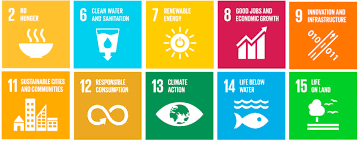The Importance of Sustainable Planning
In today’s rapidly changing world, the concept of sustainable planning has become increasingly vital. Sustainable planning involves creating urban and rural environments that meet the needs of the present without compromising the ability of future generations to meet their own needs.
One of the key aspects of sustainable planning is environmental protection. By considering the impact of development on ecosystems, water resources, air quality, and biodiversity, planners can ensure that projects are designed in a way that minimises harm to the environment.
Another crucial element of sustainable planning is social equity. Planners must strive to create inclusive communities that provide equal access to resources and opportunities for all residents. This involves addressing issues such as affordable housing, public transportation, and access to green spaces.
Economic sustainability is also a core principle of sustainable planning. By promoting economic development that is environmentally responsible and socially equitable, planners can help create resilient communities that can withstand economic shocks and thrive in the long term.
Furthermore, sustainable planning plays a key role in mitigating climate change. By promoting energy-efficient buildings, renewable energy sources, and sustainable transportation options, planners can help reduce greenhouse gas emissions and build more climate-resilient cities.
Overall, sustainable planning is essential for creating vibrant, healthy, and resilient communities that can thrive now and in the future. By integrating environmental protection, social equity, economic sustainability, and climate resilience into their work, planners can help shape a better world for generations to come.
Seven Essential Tips for Sustainable Urban Planning
- Incorporate green spaces and parks into urban planning
- Promote walking, cycling, and use of public transport
- Encourage energy-efficient building design and construction
- Implement waste reduction and recycling programs
- Support local businesses and sustainable food systems
- Protect natural habitats and wildlife in development projects
- Involve the community in decision-making processes
Incorporate green spaces and parks into urban planning
Incorporating green spaces and parks into urban planning is a crucial aspect of sustainable development. By integrating these natural elements into the urban landscape, cities can improve air quality, reduce the urban heat island effect, provide habitats for wildlife, and offer residents valuable opportunities for recreation and relaxation. Green spaces also help to enhance the overall aesthetic appeal of a city and promote physical and mental well-being among its inhabitants. Including parks and green areas in urban planning not only contributes to environmental sustainability but also creates more liveable and resilient communities for present and future generations to enjoy.
Promote walking, cycling, and use of public transport
Promoting walking, cycling, and the use of public transport is a key strategy in sustainable planning. Encouraging these modes of transportation not only reduces carbon emissions and air pollution but also promotes physical activity and improves public health. By investing in pedestrian-friendly infrastructure, cycle lanes, and efficient public transport systems, planners can create more liveable and environmentally friendly communities. This approach not only helps to reduce traffic congestion but also fosters a sense of community and connectivity among residents.
Encourage energy-efficient building design and construction
Encouraging energy-efficient building design and construction is a crucial aspect of sustainable planning. By promoting the use of sustainable materials, passive design strategies, and energy-efficient technologies, planners can help reduce the carbon footprint of buildings and minimise energy consumption. This not only lowers operating costs for building owners but also contributes to a healthier environment by decreasing greenhouse gas emissions. Sustainable buildings play a significant role in creating more resilient and sustainable communities for the future.
Implement waste reduction and recycling programs
Implementing waste reduction and recycling programs is a crucial aspect of sustainable planning. By reducing the amount of waste generated and promoting recycling practices, communities can minimise their environmental impact and conserve valuable resources. These programs not only help in diverting waste from landfills but also contribute to energy savings and the reduction of greenhouse gas emissions. Embracing waste reduction and recycling initiatives is a proactive step towards building more sustainable and eco-friendly communities for current and future generations to enjoy.
Support local businesses and sustainable food systems
Supporting local businesses and sustainable food systems is a crucial aspect of sustainable planning. By prioritising local businesses, communities can reduce their carbon footprint by minimising transportation emissions associated with importing goods. Additionally, supporting sustainable food systems promotes environmental conservation and ensures access to fresh, healthy produce for residents. By incorporating these practices into urban and rural planning, communities can foster economic resilience, reduce environmental impact, and promote the well-being of both people and the planet.
Protect natural habitats and wildlife in development projects
When engaging in sustainable planning, it is crucial to prioritise the protection of natural habitats and wildlife in development projects. By carefully considering the impact of construction and urbanisation on ecosystems, planners can ensure that development is carried out in a way that minimises disruption to the environment. Preserving natural habitats not only maintains biodiversity but also contributes to the overall health and resilience of ecosystems, benefiting both wildlife and human communities in the long run. Incorporating measures to protect natural habitats and wildlife into development projects is essential for creating sustainable environments that support a harmonious coexistence between nature and urban spaces.
Involve the community in decision-making processes
Incorporating community involvement in decision-making processes is a fundamental aspect of sustainable planning. By engaging with local residents, stakeholders, and community groups, planners can gain valuable insights into the needs and priorities of the people who will be directly impacted by development projects. Community participation fosters a sense of ownership and empowerment among residents, leading to more inclusive and equitable planning outcomes that reflect the diverse perspectives and values of the community. This collaborative approach not only enhances the legitimacy of decisions but also promotes social cohesion and builds trust between planners and the community, ultimately contributing to the long-term sustainability of development initiatives.

